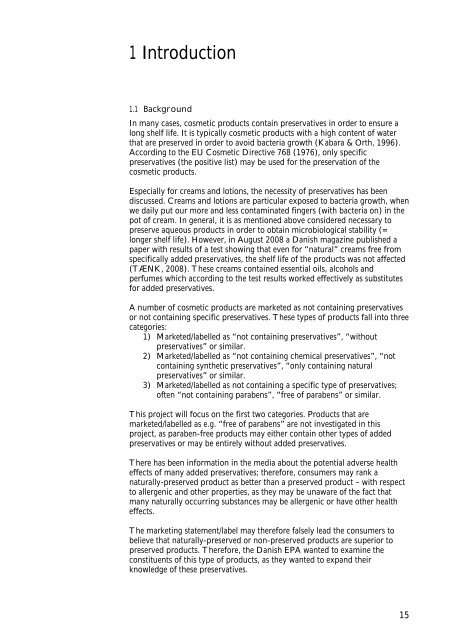Survey and health assessment of cosmetic products ... - Miljøstyrelsen
Survey and health assessment of cosmetic products ... - Miljøstyrelsen
Survey and health assessment of cosmetic products ... - Miljøstyrelsen
You also want an ePaper? Increase the reach of your titles
YUMPU automatically turns print PDFs into web optimized ePapers that Google loves.
1 Introduction<br />
1.1 Background<br />
In many cases, <strong>cosmetic</strong> <strong>products</strong> contain preservatives in order to ensure a<br />
long shelf life. It is typically <strong>cosmetic</strong> <strong>products</strong> with a high content <strong>of</strong> water<br />
that are preserved in order to avoid bacteria growth (Kabara & Orth, 1996).<br />
According to the EU Cosmetic Directive 768 (1976), only specific<br />
preservatives (the positive list) may be used for the preservation <strong>of</strong> the<br />
<strong>cosmetic</strong> <strong>products</strong>.<br />
Especially for creams <strong>and</strong> lotions, the necessity <strong>of</strong> preservatives has been<br />
discussed. Creams <strong>and</strong> lotions are particular exposed to bacteria growth, when<br />
we daily put our more <strong>and</strong> less contaminated fingers (with bacteria on) in the<br />
pot <strong>of</strong> cream. In general, it is as mentioned above considered necessary to<br />
preserve aqueous <strong>products</strong> in order to obtain microbiological stability (=<br />
longer shelf life). However, in August 2008 a Danish magazine published a<br />
paper with results <strong>of</strong> a test showing that even for “natural” creams free from<br />
specifically added preservatives, the shelf life <strong>of</strong> the <strong>products</strong> was not affected<br />
(TÆNK, 2008). These creams contained essential oils, alcohols <strong>and</strong><br />
perfumes which according to the test results worked effectively as substitutes<br />
for added preservatives.<br />
A number <strong>of</strong> <strong>cosmetic</strong> <strong>products</strong> are marketed as not containing preservatives<br />
or not containing specific preservatives. These types <strong>of</strong> <strong>products</strong> fall into three<br />
categories:<br />
1) Marketed/labelled as “not containing preservatives”, “without<br />
preservatives” or similar.<br />
2) Marketed/labelled as “not containing chemical preservatives”, “not<br />
containing synthetic preservatives”, “only containing natural<br />
preservatives” or similar.<br />
3) Marketed/labelled as not containing a specific type <strong>of</strong> preservatives;<br />
<strong>of</strong>ten “not containing parabens”, “free <strong>of</strong> parabens” or similar.<br />
This project will focus on the first two categories. Products that are<br />
marketed/labelled as e.g. “free <strong>of</strong> parabens” are not investigated in this<br />
project, as paraben-free <strong>products</strong> may either contain other types <strong>of</strong> added<br />
preservatives or may be entirely without added preservatives.<br />
There has been information in the media about the potential adverse <strong>health</strong><br />
effects <strong>of</strong> many added preservatives; therefore, consumers may rank a<br />
naturally-preserved product as better than a preserved product – with respect<br />
to allergenic <strong>and</strong> other properties, as they may be unaware <strong>of</strong> the fact that<br />
many naturally occurring substances may be allergenic or have other <strong>health</strong><br />
effects.<br />
The marketing statement/label may therefore falsely lead the consumers to<br />
believe that naturally-preserved or non-preserved <strong>products</strong> are superior to<br />
preserved <strong>products</strong>. Therefore, the Danish EPA wanted to examine the<br />
constituents <strong>of</strong> this type <strong>of</strong> <strong>products</strong>, as they wanted to exp<strong>and</strong> their<br />
knowledge <strong>of</strong> these preservatives.<br />
15

















